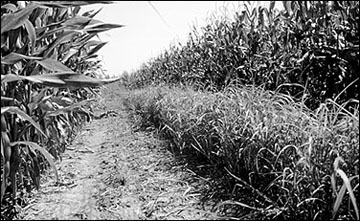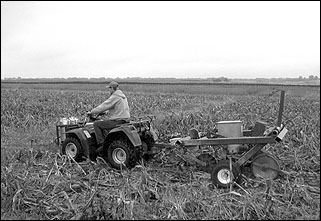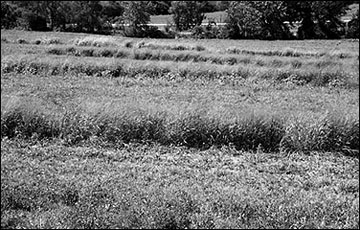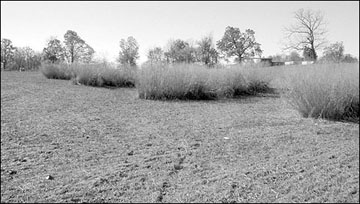The use of stiff-stemmed vegetation as barrier strips in cropland areas vulnerable to erosion is a new conservation practice that can augment more conventional measures designed to reduce soil losses. This publication highlights current strategies for incorporating vegetative barriers into a soil conservation program.

Vegetative barriers are narrow, parallel strips of stiff, erect, dense vegetation planted on or close to the contour. These barriers cross concentrated flow areas at convenient angles for farming or are used in the same manner as terraces. Vegetative barriers differ from conventional grass buffer strips: they are narrow (less than 5 feet wide) and use perennial stiff-stemmed vegetation (Figure 1). They reduce the velocity of runoff water, causing deposition of sediments on the upslope side of the barriers. Reduced velocity also prevents scouring and lessens ephemeral gully development. Over a period of years, barriers form terrace-like benches that can be maintained and enhanced.
Applications of vegetative barriers
- Vegetative terraces for erosion control
Barriers of stiff-stemmed grasses control sheet and rill erosion, trap sediment and facilitate benching of sloping cropland. - Barriers to gully formation
In areas of concentrated water flow, deep-rooted barriers distribute the flow over a broader area and provide a stable point that prevents head cuts from working their way up a slope. - Field borders
Vegetative barriers around fields reduce the amount of sediment carried outside the field, prevent development of head cuts into the field and ensure uniform flow into streams and ditches. - Aids to conventional conservation practices
In areas of concentrated flow, vegetative barriers in the upper 3 feet of contour buffer strips can disperse runoff flow so that more of the runoff flows through, rather than over, vegetation in the strips. They also provide additional wildlife cover and increase biodiversity in field borders of predominantly sod-forming grasses.
Vegetation selection
Various types of vegetation can be used in vegetative barriers. Requirements for suitable vegetation are as follows:
- Perennial with stiff stems that remain intact year-round; not invasive.
- Tolerant of both dry and wet soil conditions.
- Ability to emerge though several inches of sediment or to resume growth from buried stem nodes and with rhizomatous or stoloniferous growth characteristics.
Two grasses, switch grass (Panicum virgatum L.) and eastern gamagrass (Tripsacum dactyloides), have the desired characteristics. Both switch grass and gamagrass are native, warm-season plants.
Switch grass
Switch grass produces small seeds similar to those of foxtail, which it resembles in its phenotype. To establish a vigorous stand, switch grass should be spring planted at a rate of 8-10 pounds of pure live seed per acre. It generally takes two years to reach maximum growth potential because of slow germination and seedling growth. Stands that appear poor at the end of the first year usually develop into good stands the second year. It is important to evaluate stands at the end of the seeding year. If there are at least 1 to 3 seedlings per square foot in September, the stand is adequate.
Gamagrass
Gamagrass is closely related to corn and produces seeds of a similar size. The seed needs to be stratified (cold storage for extended periods of time) to have good germination. Gamagrass needs to be planted at a rate of 15 pounds per acre at the same depth as corn and should be handled in the same way. Following recommended establishment procedures helps to reduce weed competition. If tillage is done early, weeds are allowed to germinate and are then eliminated with a contact herbicide or a light harrowing or disking before seeding. Mowing weeds to reduce shading may be beneficial; weeds should be clipped at a height above the grass seedlings and not later than early August. Broadleaf weeds can be controlled with herbicides when the grasses are seedlings. However, since warm-season grasses generally have deep root systems, fertility is not as critical as it is for cool-season grasses.
Mixtures of grasses
Barriers can be established with either switch grass or gamagrass, but when barriers are to be established from seed, it is advisable to seed both grasses at the same time. This will prevent a complete stand failure if one of the grasses does not have adequate germination. The mixture of the upright, stiff switchgrass and the less rigid gamagrass makes for barriers with increased density and diversity for wildlife habitat.
Vegetation establishment
Methods
Vegetative barriers can be established either vegetatively or from seed. Vegetatively propagated barriers trap more sediment immediately and are not as subject to failure from washouts or burial by sediment. Seeding requires less material and labor and, therefore, is less expensive. An all-terrain vehicle can be used with a one-row, no-till planter, which can be purchased or custom-made for this purpose (Figure 2). Because of the number of row feet involved in terrace applications, seeding is recommended. For critical flow areas, the use of live plants is recommended.

Barriers established vegetatively should be planted at a spacing sufficiently dense to ensure a functional hedge in one growing season. Although planting a continuous sod strip would be best, planting a single row of slips (bare-root seedlings or greenhouse-grown transplants) at a 6-inch spacing can create a functional hedge in two years. Even where gaps between transplanted clumps are still distinguishable, crop residue bridges these gaps and makes the hedge effective in slowing runoff and trapping sediment. In concentrated flow areas, a double row of continuous sod strips, or rows planted 12 to 18 inches apart with a 6- to 8-inch spacing of 4-inch-diameter clumps is recommended.
Barriers established from seed should be sown using the normal technology for warm-season grass establishment. Seed should be sown, either in a strip at least 3 feet wide or in rows, (a minimum of three rows is recommended) with at least one seed every inch. Seeds should be placed at optimum depth, and the seedbed should be packed after seeding. In most cases this mandates the use of a drill to place the seed at the precise rate and recommended depth. Installing straw bales may enhance establishment by plants or seed; burlap silt fences or fiber rolls should be placed immediately downslope of the barrier location in concentrated flow areas. This reduces scour and promotes water conservation for the young plants.
Timing
Different establishment times are possible with warm-season grasses. Early fall seeding of warm-season grasses is not feasible, as it is with cool-season grasses. However, warm-season grasses can be seeded during dormancy from October until March or in early spring, before crops have been planted. If a dormant seeding is planned, gamagrass seed does not have to be stratified. Usually last year's residue will give a good indication of the row direction and can be used to space the barriers. Besides a thorough survey for spacing considerations, this operation requires close attention because of the need to till around barriers that have not yet emerged.
Planting barriers after the crop has been planted and as soon as possible after germination makes for easier establishment. An operator will need to follow and count crop rows to achieve the optimal direction and uniform spacing of barrier strips. A cost associated with this "post-planting" method of establishing barriers is the loss of the crop seed that is overplanted by the barrier strips.
Herbicide considerations
An understanding of herbicide interference is critical in establishing a vegetative barrier. Gamagrass and switch grass are related to corn and are tolerant of the same herbicides as corn. However, in the first three years after planting, care must be taken to avoid soybean herbicide applications over the barriers. Transplants and seedlings are sensitive to soybean herbicides. Because herbicide drift cannot be avoided, a setback distance of 10 feet on either side of the barriers must be maintained in the years when soybeans are planted. Weeds in the barriers can be especially detrimental in the seeding year because of the slow growth of warm-season grass seedlings and because of competition from broadleaf weeds and foxtail. Weeds should be controlled with an integrated control strategy using cultural, mechanical and chemical methods. Atrazine application over the barriers will effectively reduce this competition. Successful establishment depends on judicious use of herbicides, both on the crop and on the barriers.
Soil erosion control
Vegetative terraces
Type of erosion reduction

Vegetative terraces reduce sheet and rill erosion in several ways (Figure 3). First, they increase water infiltration and thus reduce the total volume of runoff. Second, reducing the velocity of the runoff water causes the upslope deposition of sediment, in effect reducing the slope between barriers. Third, the redistribution of runoff water creates sheet flow, which is less erosive than concentrated flow.
Design and layout
The vertical interval (VI), or vertical fall between successive barrier centers, sets the limit on hedge design spacing. The maximum vertical interval for this purpose is 6 feet or less if the spacing calculated by formulas for terraces yield smaller values (refer to Conservation Practice Standard 600 in the NRCS Field Office Technical Guide). Tillage not only creates conditions conducive to water erosion but also moves soil directly downslope. Where conventional tillage is used, slope gradients between barriers become flatter and more uniform over time, and contour lines gradually align with the barriers. Some tillage operations move soil directly into vegetative barriers. Berms formed in this way may divert runoff along the barriers in the same way that terraces redirect water. This diversion of runoff reduces erosion between barriers, but also results in increased flow of water and wetness where barriers cross low spots in a field. In these low areas, concentrated runoff is retarded and dispersed as it passes through the vegetative barriers.
Gradients along barriers should be 0.6 percent or less except where the vegetative barriers cross concentrated flow areas. Steeper gradients may exist for a distance of 100 feet on either side of the concentrated flow area. Where the gradient along the crop row is too steep, barriers serve no function.
Practical experience
Experience shows that barriers must be consistent with the row direction. In theory, a producer can lay out barriers at will and then adjust the row direction accordingly. In practice, row direction in a field has been finalized over time, generally on the contour, and is not negotiable. Because adjusting rows to barriers is not feasible, contour farming is a prerequisite for barrier establishment. Vegetative barriers are arranged parallel to each other on or near the contour, but they cross concentrated flow areas at angles convenient for farming. All tillage is parallel to the vegetative barriers and contributes significantly to the leveling and benching between vegetative barriers.
Soil loss reduction
The Natural Resources Conservation Service and the Farm Service Agency of the U.S. Department of Agriculture estimate soil loss through use of the Revised Universal Soil Loss Equation (RUSLE). This equation computes soil loss in tons per acre for a given field as the product of several factors: average rainfall, soil type, length and steepness of slope, crop residue (e.g., no-till), and farming practice (e.g., terracing). Estimated erosion control improves with modification to the factors that describe farming practice and the length and steepness of the slope. This improvement depends on the design, management and maturity of the barriers. When initially established, the barriers serve as guides for contour cultivation and receive a better RUSLE score for contouring and strip-cropping, which reflect alignment and vegetation characteristics. After barriers are well established and begin to create a backwater that causes sediment to be deposited upslope of the actual vegetative barrier area, the effective width of the barrier should be used rather than the actual width of the grass in RUSLE computations.
For planning purposes, it is also worthwhile to use RUSLE calculations to estimate the amount of erosion that would occur if vegetative barriers diverted flow and acted as terraces. In this case, slope length is reduced to the barrier spacing, and estimated soil loss decreases because of reduced length and steepness of slope and because of the use of contouring and terracing.
Concentrated flow areas and grass waterways
Type of erosion reduction

Waterways are designed to remove water from a field under controlled conditions. High flow velocities make the bottoms of waterways subject to gully erosion and head cutting within the profile. Additionally, establishment of cool-season grass cover can be difficult. Vegetative barriers can help stabilize waterways, much like the use of hay bales, when established at designed intervals across concentrated flow channels. Their uniform dispersal and slowing of runoff, together with their root systems, make established, permanent, live barriers more effective than hay bales. In concentrated flow areas or waterways, the deep roots of barriers not only redistribute the flow but also provide a stable point that stops head cuts from working their way up the slope (Figure 4).
Design and layout
Where sheet and rill erosion are controlled with other practices such as residue management, separate barrier sections may be installed across concentrated flow areas to control ephemeral gully development. When used to control only ephemeral erosion, barriers need to be long enough to prevent bypass flow around the ends. This bypass flow can be avoided if each strip is extended far enough to provide 1.25 feet of elevation above the base level section that will develop after a few years of sedimentation.
Experience has shown that established barriers are stable if the length of the level base section (measured in feet) is numerically greater than the contributing area (measured in acres) of the watershed above the barrier. This level base section will form gradually over time, but where contributing areas are large, some earth-moving may be desirable before vegetative barriers are established to create this level base section for dispersing runoff. In concentrated flow areas, barriers should be at least 3 feet wide and should consist of at least 2 rows of vegetation. The maximum vertical height difference between two barriers is reduced to 4 feet. Vegetation should be maintained at a height of at least 15 inches throughout the year. Backwater created above each barrier protects the submerged areas from high-velocity flows and further erosion. Benching continues until the backwater from a downslope barrier submerges the base of the next barrier upslope and erosion below the upslope barriers ceases. Therefore, the barrier farthest downslope in a field should be located in the foot slope area below which ephemeral gully development is not anticipated and where the velocity of dispersed runoff leaving the barriers does not exceed critical values for the soil conditions that exist downslope from the barrier.
Practical experience
Establishing vegetative barriers in high flow areas is practical only by using live plants. If possible the plants should be dug and replanted in the same day. Soil quality in ephemeral gullies is usually poor; extra initial watering greatly aids in plant establishment. In waterways, barriers are typically about 25 feet long and 90 feet apart. If a barrier is to be established with dug plants that have a root-ball diameter of 8 inches or more, one row of plants will suffice, whereas at least two rows are required for barriers begun with small plugs.
Management of barriers
Management of barriers is simple. If residue becomes so thick that it starts to smother the barriers, it can be either burned or mowed. However, experience in Missouri and other states suggests that barriers can remain effective for five years or more with no mowing or burning. Mowing increases stem density but decreases stem thickness (stiffness). Because of the height difference above and below well-established barriers, it may be necessary to use a a sickle bar mower rather than a brush hog. Burning will reduce the barrier's effectiveness temporarily. Tillage or use of herbicides in the crop field adjacent to the barrier will prevent barriers from spreading. If a hole forms in the barrier, it can be repaired simply by digging a few plants and placing them in the gap.
Further information
- Dewald, C.L., S. Bruckerhoff, S. Dabney, J. Douglas, J. Heniy, J. Ritchie, D. Shepherd, and D. Wolf. 1996. Guidelines for the establishment of warm-season grass hedges for Erosion Control. J. Soil and Cons. 51:16-20.
- Dillaha, T.A., and J.C. Hayes. 1992. Vegetative filter strips: II. Application of design procedures. ASAE Paper number 922103. American Society of Agricultural Engineers, St. Joseph, Mich.